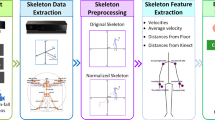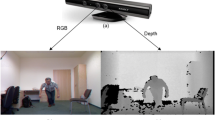Abstract
In this work we are interested in detecting fall from a non-fall event by means of visual information. A non-fall event can be an activity of daily living (ADL) such as when a person is sitting, walking, lying on the floor, picking up an object. We propose a fall detection system based on a set of visual features, which captures the following information: whether the person is in balance, is close to the ground, the dispersion of joint heights and their change in a time window. The feature set is computed from the joint data provided by the Kinect. The sequences performed by the odd subjects from the TST Fall detection v2 dataset are used to generate the classifier, which is a support vector machine (SVM). This database provides the position of the skeletal joints for actions such as ADL and 4 types of falls. Subsequently, the proposed system is validated with the sequences executed by the even subjects from the TST v2 fall detection dataset and the other two publicly available 3D action datasets. The obtained recognition accuracy is respectively 89.5%, 97.2% and 96%. The experimental results show that the captured features are useful to detect the fall in datasets that are first seen by the classifier.

















Similar content being viewed by others
References
Agahian S, Negin F, Köse C (2019) Improving bag-of-poses with semi-temporal pose descriptors for skeleton-based action recognition. Vis Comput 35 (4):591–607
Baskoro AS, Priyono MG (2016) Design of humanoid robot stable walking using inverse kinematics and zero moment point. In: 2016 International electronics symposium (IES). IEEE, pp 335–339
Cameron R, Zuo Z, Sexton G, Yang L (2017) A fall detection/recognition system and an empirical study of gradient-based feature extraction approaches. In: UK Workshop on computational intelligence. Springer, pp 276–289
Chatzaki C, Pediaditis M, Vavoulas G, Tsiknakis M (2016) Human daily activity and fall recognition using a smartphone’s acceleration sensor. In: International conference on information and communication technologies for ageing well and e-health. Springer, pp 100–118
Chen C, Jafari R, Kehtarnavaz N (2015) Utd-mhad: a multimodal dataset for human action recognition utilizing a depth camera and a wearable inertial sensor. In: 2015 IEEE International conference on image processing (ICIP). IEEE, pp 168–172
Chen C, Jafari R, Kehtarnavaz N (2017) A survey of depth and inertial sensor fusion for human action recognition. Multimed Tools Appl 76(3):4405–4425
Chen L, Wei H, Ferryman J (2013) A survey of human motion analysis using depth imagery. Pattern Recogn Lett 34(15):1995–2006
Cippitelli E, Gasparrini S, Gambi E, Spinsante S (2016) A human activity recognition system using skeleton data from rgbd sensors. Computational Intelligence and Neuroscience, 2016. https://doi.org/10.1155/2016/4351435
Dekker M (2009) Zero-moment point method for stable biped walking. Eindhoven University of Technology
Gasparrini S, Cippitelli E, Gambi E, Spinsante S, Wåhslén J, Orhan I, Lindh T (2016) Proposal and experimental evaluation of fall detection solution based on wearable and depth data fusion. In: ICT Innovations 2015. Springer, pp 99–108
Goldberg DE, et al. (2002) The Design of Innovation: Lessons from and for Competent Genetic Algorithmsby David E. goldberg, vol 7. Springer Science & Business Media, Berlin
Gutiérrez J, Rodríguez V, Martin S (2021) Comprehensive review of vision-based fall detection systems. Sensors 21(3). https://doi.org/10.3390/s21030947. https://www.mdpi.com/1424-8220/21/3/947
Hadjadji B, Saumard M, Aron M (2022) Multi-oriented run length based static and dynamic features fused with choquet fuzzy integral for human fall detection in videos. J Visual Commun Image Represent 82:103,375. https://doi.org/10.1016/j.jvcir.2021.103375
Hernandez-Mendez S, Maldonado-Mendez C, Marin-Hernandez A, Rios-Figueroa HV (2017) Detecting falling people by autonomous service robots: a ros module integration approach. In: Electronics, communications and computers (CONIELECOMP), 2017 international conference on. IEEE, pp 1–7
Htoo CK, Sein MM (2019) Geometric kinect joints computing for human fall recognition. Seventeenth International Conference on Computer Applications (ICCA), 2019
Kepski M, Kwolek B (2017) Event-driven system for fall detection using body-worn accelerometer and depth sensor. IET Comput Vis 12(1):48–58
Keskes O, Noumeir R (2021) Vision-based fall detection using st-gcn. IEEE Access 9:28,224–28,236. https://doi.org/10.1109/ACCESS.2021.3058219
Maldonado-Mendez C, Hernandez-Mendez S, Hernandez-Ventura JD (2019) Fall recognition system: a review. In: 2019 IEEE International conference on engineering veracruz (ICEV), vol 1. IEEE, pp 1–6
Maldonado-Mendez C, Solis AL, Rios-Figueroa HV, Marin-Hernandez A (2017) Human fallen pose detection by using feature selection and a generative model. In: Power, electronics and computing (ROPEC), 2017 IEEE international autumn meeting on. IEEE, pp 1–6
Merrouche F, Baha N (2016) Depth camera based fall detection using human shape and movement. In: Signal and image processing (ICSIP), IEEE international conference on. IEEE, pp 586–590
Min W, Yao L, Lin Z, Liu L (2018) Support vector machine approach to fall recognition based on simplified expression of human skeleton action and fast detection of start key frame using torso angle. IET Comput Vis 12(8):1133–1140
Organization WH, Ageing WHO, Unit LC (2008) WHO global report on falls prevention in older age. World Health Organization
Qin Y, Mo L, Li C, Luo J (2020) Skeleton-based action recognition by part-aware graph convolutional networks. The Visual Computer 36 (3):621–631
Ren L, Peng Y (2019) Research of fall detection and fall prevention technologies: a systematic review. IEEE Access 7:77,702–77,722. https://doi.org/10.1109/ACCESS.2019.2922708
Sardain P, Bessonnet G (2004) Forces acting on a biped robot. center of pressure-zero moment point. IEEE Transactions on Systems Man, and Cybernetics-Part A: Systems and Humans 34(5):630–637
Seredin O, Kopylov A, Huang SC, Rodionov D (2019) A skeleton features-based fall detection using microsoft kinect v2 with one class-classifier outlier removal. ISPRS - International Archives of the Photogrammetry. Remote Sensing and Spatial Information Sciences XLII-2/W12, 189–195. https://doi.org/10.5194/isprs-archives-XLII-2-W12-189-2019
Simon J (2012) Prince: Computer vision, Models, learning, and inference
Sucerquia A, López J. D, Vargas-Bonilla JF (2017) Sisfall: A fall and movement dataset. Sensors 17(1):198
Sun X, Zhao K, Jiang W, Jin X (2021) Method of analyzing and managing volleyball action by using action sensor of mobile device. J Sens, 2021. https://doi.org/10.1155/2021/6232968
Valcourt L, De La Hoz Y, Labrador M (2016) Smartphone-based human fall detection system. IEEE Lat Am Trans 14(2):1011–1017
Wilmart R, Rocha-Cózatl E, Narváez-Aroche O (2014) Computation of the safety zmp zone for a biped robot based on error factors
Xia L, Chen C, Aggarwal J (2012) View invariant human action recognition using histograms of 3d joints. In: Computer vision and pattern recognition workshops (CVPRW), 2012 IEEE computer society conference on. IEEE, pp 20–27
Xu Y, Chen J, Yang Q, Guo Q (2019) Human posture recognition and fall detection using kinect v2 camera. In: 2019 Chinese control conference (CCC). IEEE, pp 8488–8493
Yan S, Xiong Y, Lin D (2018) Spatial temporal graph convolutional networks for skeleton-based action recognition. In: Proceedings of the AAAI conference on artificial intelligence, vol 32
Yao L, Yang W, Huang W (2019) An improved feature-based method for fall detection. Tehnički vjesnik 26(5):1363–1368
Yu X (2008) Approaches and principles of fall detection for elderly and patient. In: E-health networking, applications and services, 2008. Healthcom 2008. 10th international conference on. IEEE, pp 42–47
Zhang J, Tang ZH, Gui W.hH., Chen Q, Liu J (2017) Interactive image segmentation with a regression based ensemble learning paradigm. Frontiers of Information Technology & Electronic Engineering 18(7):1002–1020. https://doi.org/10.1631/FITEE.1601401
Zhang J, Ye G, Tu Z, Qin Y, Qin Q, Zhang J, Liu J (2020) A spatial attentive and temporal dilated (satd) gcn for skeleton-based action recognition. CAAI Transactions on Intelligence Technology. https://doi.org/10.1049/cit2.12012
Author information
Authors and Affiliations
Corresponding author
Ethics declarations
Conflict of Interests
The authors, Carolina Maldonado-Mendez, Sergio Hernandez-Mendez, Delia Torres-Muñoz and Carlos Hernandez-Mejia, declare that they have no conflict of interest.
Additional information
Publisher’s note
Springer Nature remains neutral with regard to jurisdictional claims in published maps and institutional affiliations.
Rights and permissions
About this article
Cite this article
Maldonado-Mendez, C., Hernandez-Mendez, S., Torres-Muñoz, D. et al. Fall detection using features extracted from skeletal joints and SVM: Preliminary results. Multimed Tools Appl 81, 27657–27681 (2022). https://doi.org/10.1007/s11042-022-12405-1
Received:
Revised:
Accepted:
Published:
Issue Date:
DOI: https://doi.org/10.1007/s11042-022-12405-1




